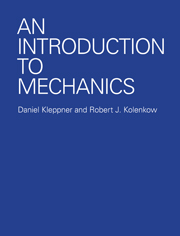Book contents
- Frontmatter
- Contents
- LIST OF EXAMPLES
- PREFACE
- TO THE TEACHER
- AN INTRODUCTION TO MECHANICS
- 1 VECTORS AND VECTORS KINEMATICS—A FEW MATHEMATICAL PRELIMINARIES
- 2 NEWTON'S LAWS—THE FOUNDATIONS OF NEWTONIAN MECHANICS
- 3 MOMENTUM
- 4 WORK AND ENERGY
- 5 SOME MATHEMATICAL ASPECTS OF FORCE AND ENERGY
- 6 ANGULAR MOMENTUM AND FIXED AXIS ROTATION
- 7 RIGID BODY MOTION AND THE CONSERVATION OF ANGULAR MOMENTUM
- 8 NONINERTIAL SYSTEMS AND FICTITIOUS FORCES
- 9 CENTRAL FORCE MOTION
- 10 THE HARMONIC OSCILLATOR
- 11 THE SPECIAL THEORY OF RELATIVITY
- 12 RELATIVISTIC KINEMATICS
- 13 RELATIVISTIC MOMENTUM AND ENERGY
- 14 FOUR VECTORS AND RELATIVISTIC INVARIANCE
- INDEX
14 - FOUR VECTORS AND RELATIVISTIC INVARIANCE
- Frontmatter
- Contents
- LIST OF EXAMPLES
- PREFACE
- TO THE TEACHER
- AN INTRODUCTION TO MECHANICS
- 1 VECTORS AND VECTORS KINEMATICS—A FEW MATHEMATICAL PRELIMINARIES
- 2 NEWTON'S LAWS—THE FOUNDATIONS OF NEWTONIAN MECHANICS
- 3 MOMENTUM
- 4 WORK AND ENERGY
- 5 SOME MATHEMATICAL ASPECTS OF FORCE AND ENERGY
- 6 ANGULAR MOMENTUM AND FIXED AXIS ROTATION
- 7 RIGID BODY MOTION AND THE CONSERVATION OF ANGULAR MOMENTUM
- 8 NONINERTIAL SYSTEMS AND FICTITIOUS FORCES
- 9 CENTRAL FORCE MOTION
- 10 THE HARMONIC OSCILLATOR
- 11 THE SPECIAL THEORY OF RELATIVITY
- 12 RELATIVISTIC KINEMATICS
- 13 RELATIVISTIC MOMENTUM AND ENERGY
- 14 FOUR VECTORS AND RELATIVISTIC INVARIANCE
- INDEX
Summary
Introduction
When a major advance in physics is made, old concepts inevitably lose importance and points of view which previously were of minor interest move to the center. Thus, with the advent of relativity the concept of the ether vanished, taking with it the problem of absolute motion. At the same time, the transformation properties of physical laws, previously of little interest, took on central importance. As we shall see in this chapter, transformation theory provides a powerful tool for generalizing nonrelativistic concepts and for testing the relativistic correctness of physical laws. Furthermore, it is a useful guide in the search for new laws. By using transformation theory we shall derive in a natural way the important results of relativity that we found by ad hoc arguments in the preceding chapters. This approach emphasizes the mathematical structure of physics and the nature of symmetry; it illustrates a characteristic mode of thought in contemporary physics.
To introduce the methods of transformation theory, we defer relativity for the moment and turn first to the transformation properties of ordinary vectors in three dimensions.
Vectors and Transformations
In Chap. 1 we defined vectors as “directed line segments”; with the help of transformation theory we can develop a more fundamental definition.
To motivate the argument and to illustrate the ideas of transformation theory we shall rely at first on our intuitive concept of vectors.
Information
- Type
- Chapter
- Information
- An Introduction to Mechanics , pp. 515 - 538Publisher: Cambridge University PressPrint publication year: 2010
